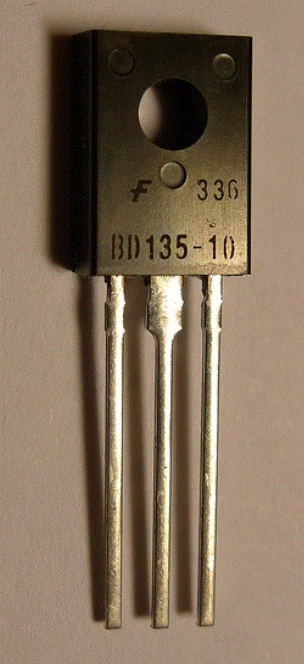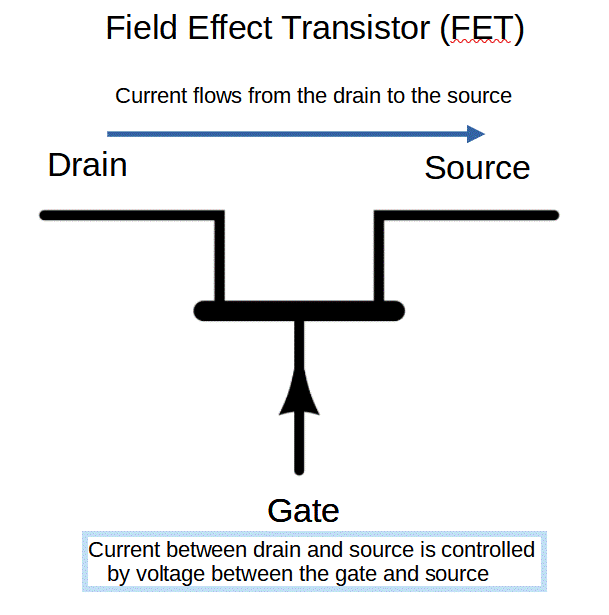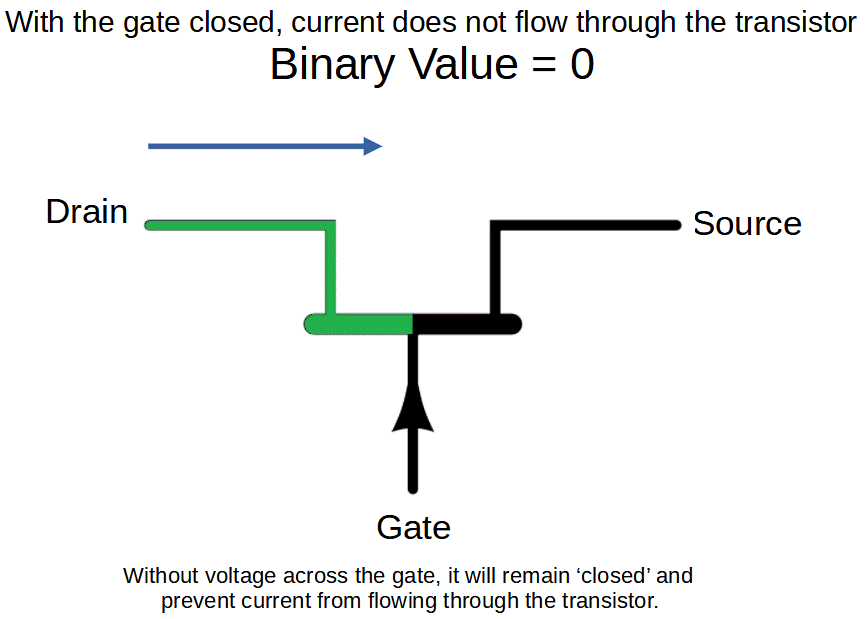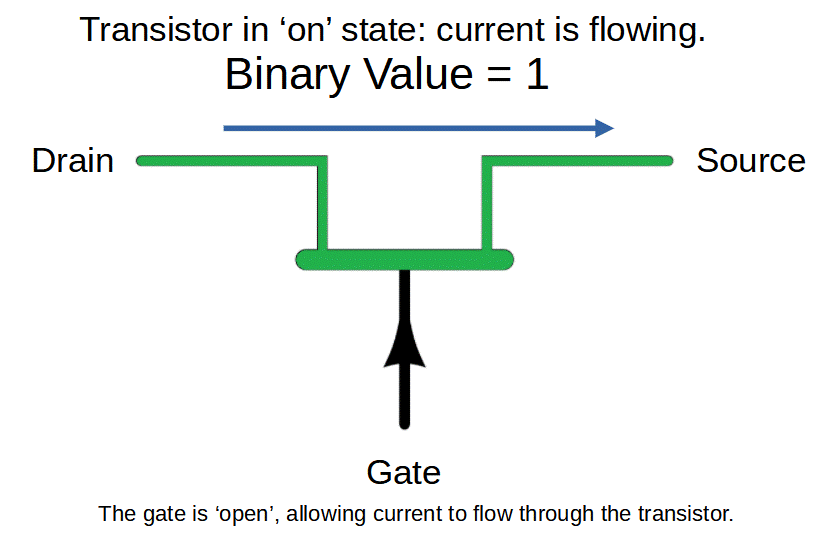Transistors
Transistors are perhaps the most important electronic devices ever created. Transistors are multi-terminal semiconductor devices that function either as switches or amplifiers of electric signals.
Transistors replaced earlier vacuum tubes in electronic circuits. Their robustness and ability to be scaled down in size has led to incredible increases in computer performance and reliability. Transistor based logic circuits are at the heart of computer processors and memory.

What are Transistors?
Let’s analyze our definition of transistors above. First, transistors are semiconductor devices. Like other semiconductor devices, such as diodes, transistors are made of doped regions on a semiconductor substrate.
Transistors are devices that have multiple (either two or three) inputs and one output. Current flows between only one of the inputs and the output. The main action of a transistor is to control the current between the primary input and output. The other input(s) are used to control that current.
Model of a Transistor
The simplest type of transistor is called a bipolar junction transistor (BJT). Bipolar junction transistors (BJTs) are essentially just two P-N junctions placed back to back, in either NPN or PNP configurations. BJTs therefore have three doped regions, and one terminal for each region.
The three terminals correspond to two inputs and one output. The two input terminals are called the base and collector, and the output terminal is called the emitter. A voltage on the base (as measured between base and emitter) controls the current between the collector and emitter.
A great way to think about transistors is as a valve controlling the flow of current between two terminals. Just as a valve can be mechanically (or electrically) operated into different positions in order to control fluid flow, the voltage on the base of a BJT controls the flow of current between the emitter and collector.


If the voltage between the base and emitter is zero, the transistor is in an ‘off’ state. There will be no current between the collector and emitter.
This allows the transistor to function as a switch, turning the current on or off between the collector and emitter.
When a voltage is applied across the base and emitter, the transistor switches ‘on’, allowing current to flow between the collector and emitter. Only a small amount of current passes from the base to the emitter.
Higher voltages causes a much greater change in the output voltage between the collector and emitter. This allows the transistor to function as an amplifier, with the voltage on the base amplifying the voltage across the collector and emitter. Note that energy is not created in an amplifier; an amplifier’s function is to use one signal to disproportionately increase another signal, not to create energy out of nothing (which is physically impossible).

Transistors only function as switches or amplifiers when they are placed into an appropriately designed circuit. This is why it is best to think of transistors as valves, rather than switches or amplifiers.

The other common type of transistor is called a field effect transistor (FET). In a field effect transistor (FET), the functionality is much the same but the three terminals have different names. FETs use the terms gate, source, and drain to describe the three terminals.
In an FET, current flows from the drain to the source and is controlled by a voltage between the gate and source.
Transistor as a Switch
As switches, transistors are incredibly useful in logic circuits, where one input (on the base in an BJT or on the gate in an FET) can control an output signal that corresponds to a binary signal, ‘0’ for false and ‘1’ for true.
Early computers used vacuum tubes and relays to perform the switching function, and systems based on switching logic systems were developed long before transistors were invented. In fact, the systematic theory of logic based on a binary system was developed in the 19th century.
In modern electronics, the transistor’s switching action facilitates the use of binary logic in circuits. When a transistor acts to allow current to pass by switching ‘on’, it functions as a value of ‘1’. When it switches off and prevents current, it functions as a value of ‘0’. This input is then used in logic circuits to perform the more complex operations that allow computers to function.
Binary Logic Using a Field Effect Transistor
Most computer technology use field effect transistors to perform binary logic.
Let’s see how computers use FET transistors as switches to allow for binary logic. When there is no voltage between the gate and source, the transistor is ‘off’ because current does not flow between the drain and source. This corresponds to a binary value of ‘0’.


When a voltage is placed across the gate and source, the transistor switches to the ‘on’ state. Current is now allowed to flow between the drain and source. This corresponds to a binary value of ‘1’.
The two values of ‘0’ and ‘1’ are used to perform all logical operations and also to store information in computer memory. Transistors are therefore the most critical parts of both computer processors and memory chips. That’s why transistors are so important; they are critical to the operation of modern computer systems.
Binary vs. Ternary and Other Complex Systems
Binary systems use only two values, ‘0’ and ‘1’, instead of having multiple values. Binary is used primarily because it’s harder to get wrong. For instance, ternary systems use three values and were an early competitor with binary systems. A ternary system might use the values ‘0’, ‘1’, and ‘2’. What happens when the signal is 1.4, or .6? The system might perform a calculation incorrectly due to a small difference in value. With a binary system, there are only two values that are spaced far enough apart to make this type of error uncommon.
Transistor as an Amplifier
Just as the input on the base (in a BJT) or gate (in an FET) allows the transistor to switch, an increase also results in amplification. This makes the transistor useful in many different applications, including power, audio, and radio signal amplifiers.
Transistors must be carefully chosen for their application, particularly when they are used for amplification. For example, the same transistors used as switches in logic circuits (MOSFETs) are not optimized for use in power amplification.
What Makes Transistors so Important?
Transistors are truly at the heart of modern electronics, including virtually every computer device currently produced. From cell phones to laptops and televisions, transistors are essential components to our modern existence.
The more transistors in a circuit, the more powerful that circuit can be. This leads to faster and more powerful processors and more memory in every device.
Increasing the number of transistors in integrated circuits (ICs) has been a primary goal of the semiconductor industry, in keeping with Moore’s Law. This is accomplished primarily by decreasing the size and improving the design of transistors, allowing transistor to be increased over time.
Types of Transistor
| Bipolar Junction Transistor (BJT) | Metal Oxide Semiconductor Field Effect Transistor (MOSFET) | Junction Field Effect Transistor (JFET) | |
| Method of Control | Current | Voltage | Voltage |
| Ability to Miniaturize | Low | High | Low |
| Amplification (gain) | High | Low | High |
| Gate Current (leakage) | High | Low | Low |
Bipolar Junction Transistor
The bipolar junction transistor (BJT) is the simplest type of transistor. BJTs are essentially P-N junctions with an extra doped region. There are two types of BJT, corresponding with the three doped regions; PNP and NPN. A PNP BJT has an ‘n’-doped region sandwiched between two p-doped regions. An NPN BJT has one p-doped region sandwiched between two n-doped regions. They both function similarly, with the middle region functioning as the base.
Field Effect Transistor
Field effect transistors (FETs) have several advantages over bipolar junction transistors. They require a biasing voltage, but not a current across the gate and source. This means that they can have a significantly higher input impedance and therefore require much less power than BJTs. They can also be scaled down to smaller sizes than BJTs, making them more efficient for use in integrated circuits. One downside of FETs compared with BJTs is that they offer less amplification, or gain. However, FETs designed for amplification
MOSFET Transistor
MOSFETs, or Metal Oxide Semiconductor Field Effect Transistors are the most popular electronics devices in history. They are a type of field effect transistor (FET), and are distinguished by the use of a metal oxide for the gate, making the gate an insulator. Rather than allowing a small amount of current to pass through the gate, a potential across the gate results in a capacitive action.